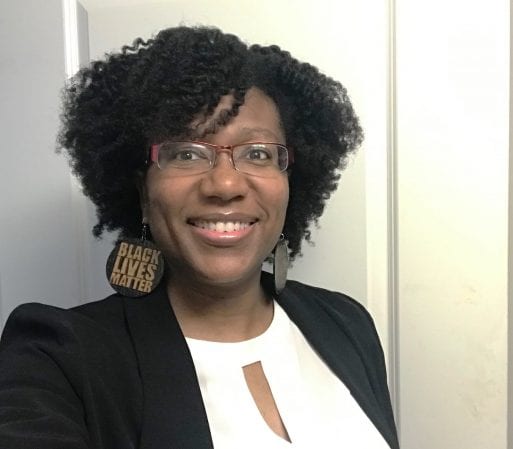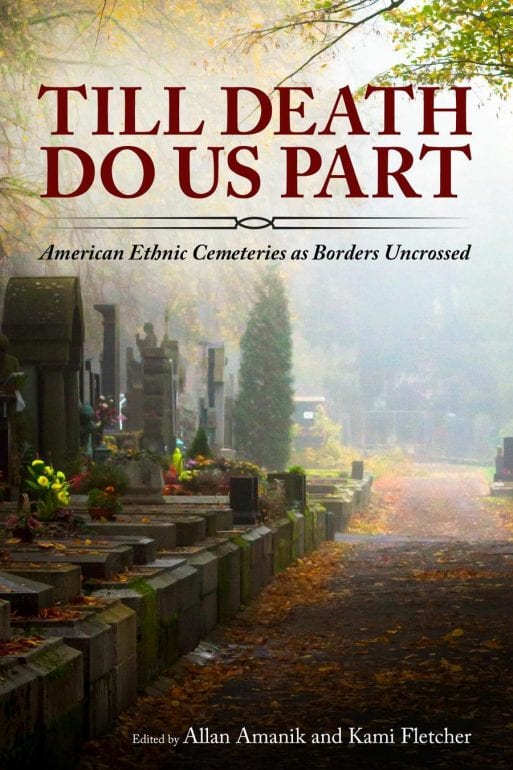 Dr. Kami Fletcher is a death scholar and professor of U.S. and African American history at Albright College. Her work focuses on African American deathways and deathwork, examining African American norms and ideas surrounding death as well as ways that death intersects with race, class, gender, religion, and region. Back in 2010, when Dr. Fletcher was a Ph.D. student of history at Morgan State University in Baltimore, she got a job working with Sharp Street Church, the first African American Methodist Church in the city to research the avenues available to restore and preserve Mount Auburn Cemetery — one of the oldest African American owned and operated burial grounds in the country. When Dr. Fletcher first set foot in the cemetery, it had been so neglected that it was completely overgrown with trees. “The cemetery just looked like a forest,” she said.
Dr. Kami Fletcher is a death scholar and professor of U.S. and African American history at Albright College. Her work focuses on African American deathways and deathwork, examining African American norms and ideas surrounding death as well as ways that death intersects with race, class, gender, religion, and region. Back in 2010, when Dr. Fletcher was a Ph.D. student of history at Morgan State University in Baltimore, she got a job working with Sharp Street Church, the first African American Methodist Church in the city to research the avenues available to restore and preserve Mount Auburn Cemetery — one of the oldest African American owned and operated burial grounds in the country. When Dr. Fletcher first set foot in the cemetery, it had been so neglected that it was completely overgrown with trees. “The cemetery just looked like a forest,” she said.
Through her work for the Sharp Street Church, Dr. Fletcher became invested in the preservation of Mount Auburn Cemetery, which has continued to be a focus of her research and a lens through which to look at inequality, segregation, and the history of African American resistance in the face of White supremacy in the United States.
Dr. Fletcher is the president and co-founder of The Collective For Radical Death Studies, an international professional organization formed to “decolonize death studies and radicalize death practice.” The collective is made up of scholars, funeral directors, deathwork practitioners, activists and students who view deathwork as synonymous with anti-racism work. The collective has compiled a Radical Death Canon, a database of source material that centers on scholarship that calls attention to the whiteness and Eurocentrism that undergirds the field of death studies. The Radical Death Canon provides resources for examining the systemic and colonial structures that impact death and dying the world over: racism, sexism, heteronormativity, capitalism, imperialism, classism and xenophobia.
In March of this year, University Press of Mississippi released Dr. Fletcher’s latest book “Till Death Do Us Part: American Ethnic Cemeteries As Borders Uncrossed,” which she co-edited along with Allan Amanik, Professor of Judaic Studies at Brooklyn College. The volume explores the tendency among Americans to separate their dead along communal lines of race, faith, ethnicity or social standing. The essays in the book look at how the ways we separate our dead can shed a broader light on American history.
Editor’s note: This interview has been edited for length and clarity.

Dr. Kami Fletcher exploring the tombs
inside the Old Cathedral of Salamanca
Did you have a specific interest in the history of Black cemeteries prior to getting the research job with Sharp Street Church as a Ph.D. student?
Actually, when I first heard about the job, I was hesitant to take it. I’m from Arkansas. For my mother and father- born in 1940 and 1943, respectively- you didn’t play around with death. You honored the dead. You didn’t go to cemeteries to walk around if you didn’t know anybody there. Back then, I didn’t understand. But I took the job, and as I learned more about the history of the cemetery, I realized that to preserve Mount Auburn Cemetery was an act of honoring the dead buried there.
Through my research, I discovered that the first iteration of the cemetery was founded in 1807 by Black folks in protest of segregation in the White Methodist church at the time. I had never considered how important these Black cemeteries were in terms of Black people taking ownership and control of their death at a time when African Americans were legally labeled the property of White merchants and planters. Through the work, I came to see preserving the cemetery as part and parcel of preserving the memory of Baltimore’s Black community. We don’t want the history of the struggle for Black dignity in and after death to be erased.
What are some of the issues you ran into as you investigated how to go about restoring and preserving Mount Auburn Cemetery?
I discovered that Mount Auburn Cemetery was listed in the National Register of Historic Places as a National Historic Landmark. They don’t receive funding by having that status, but they have certain protections. So, I began to ask, “OK, if this is going on with this cemetery, are there other cemeteries like this?” I found 114 Black cemeteries around the country that met the criteria to be listed on the National Register of Historic Places.
When I started to investigate where they were located, the heartbreaking thing I discovered was that many of them had been neglected or even just bulldozed over for development since the time of Jim Crow. White people had free rein to bulldoze these cemeteries with no regard for anybody’s sanctity or honoring the dead. So I just had a ton of questions that I’m still answering.
It costs a lot of money to enact preservation efforts, and there is no funding available for these sites, even though they’ve been established as National Historic Landmarks. When I was investigating options for the preservation of Mount Auburn, I will never forget that the first foundation that does historic preservation work we approached told us, “First, what you do is you get $500,000, and then you put that in a trust and then let that interest be what you use to keep up the grounds.” The elitism involved in preserving the dead was just jumping out all over the place. I’m still trying to dig that all up (no pun intended!).

Dr. Fletcher speaks with a student
And you became interested in African American deathways and deathwork via your involvement with Mount Auburn Cemetery?
Yes. Mount Auburn became my dissertation and has remained a focus of my research. It was the catalyst for my interest in African American deathways.
Your book “Till Death Do Us Part: American Ethnic Cemeteries as Borders Uncrossed” was just released in March. You co-edited the book with Allan Amanik, professor of Judaic studies with expertise in Jewish death and burial. What was the impetus for this book?
Take, for example, an organization like the Association for Gravestone Studies, whose mission is the preservation and study of grave markers across North America. The vast majority of their work focuses on New England cemeteries. You can go onto their website and count how many times they focus on other areas of the country: It’s not very many.
Our book, “Till Death Do Us Part,” doesn’t organize cemeteries by region; instead, we start with culture. Because death is cultural. The idea that practices around death and dying are an expression of someone’s culture is something I push in my work, and that’s what Allan Amanik and I are doing here in our volume. We’re looking at how people expressed their cultures specifically during the turn of the century amidst all of these different ideas about what it means to be an American: the melting pot, the immigration quota, the Naturalization Act of 1790, Jim Crow. Allan and I are asking the question: “Why do we separate our dead?”
We are looking at continued symbolic ethnicity through burial grounds. We’re looking at why we separate and segregate our dead: the borders between us, both self-imposed and enforced.

Credit: upress.state.ms.us
Your book was released just after much of the country received shelter-in-place orders to flatten the curve of COVID-19. Certain politicians in the U.S. have called COVID-19 “The Great Equalizer.” How would you respond to that?
I understand the sentiment, which is that nobody’s immune to COVID-19 and everybody dies eventually. But as a society, I’d like us to understand that death is not the great equalizer, because death and dying highlight the inequalities of the living. Cemeteries are a perfect example. Some people’s cemeteries are honored, while others are bulldozed to the ground to make room for a highway. Everybody dies, but everybody dies differently. COVID-19 is highlighting those inequalities the same way.
What is the origin story of the Collective For Radical Death Studies?
We came together on Twitter in November 2018. For myself and a lot of my colleagues, Twitter is a nice academic Rolodex where we can easily talk to each other, and people can engage with us who are in the field of death studies. Academia is a privileged world, and Twitter offers a way for anyone to directly engage with academics. I joined forces with Socializing for Justice (SoJust on Twitter) and we created the hashtag #sojustdeath to disseminate information about death practices in the United States. We looked at green burial, national burials and death doulas, and I brought in my work on African American deathways and deathworks. We also looked at indigenous populations and at mass death, disease and disaster.
In the midst of all of this, scholars and activists began coalescing around the idea of radicalizing death. Our mission is all about offering contributions to the field of death studies that center on the deathways and deathwork of marginalized groups. We decided that we were going to decolonize death studies and radicalize death practices — which means putting people of color and other marginalized communities at the center of death.
For the CRDS, what does it mean to put marginalized communities at the center of death?
The idea of a “good death” and the tone around death directives can be very punitive in tone. In my conversations with the people on the ground who work in green burial and natural burial and home funerals and the like, they are focused on demanding rights and lobbying at the country level, state level and federal level. When the conversation gets extended and directed and shaped in that way, Black people are losing. Because let’s say you’ve told me I have the legal right to my loved one’s body. I can keep it in my home. I do not have to call a coroner or a funeral director. I can then transport the body across state lines. Have you seen what happens when Black people stand up to the police in this country? That’s where we’re coming from at the Collective For Radical Death Studies.
It’s not that death directives and green burial are not important. But when that’s the crux of the conversation, that’s how we then get into the situation of, for example, Black people dying of COVID-19 without wills, advance directives, or living wills drawn up. We need to center the issues of marginalized people before we can start to talk about what death and dying really mean.

 Is Death Really “The Great Equalizer?” African American Deathways and Inequality in America
Is Death Really “The Great Equalizer?” African American Deathways and Inequality in America


 How Dare You Die Now!
How Dare You Die Now!
 Debating Medical Aid in Dying
Debating Medical Aid in Dying
 “Help Me, Helen”
“Help Me, Helen”














